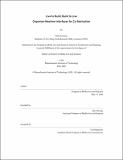Live to build, build to live : organism-machine interfaces for co-fabrication
Author(s)
Kraemer, Felix,S.M.Massachusetts Institute of Technology.
Download1193025077-MIT.pdf (4.301Mb)
Alternative title
Organism-machine interfaces for co-fabrication
Other Contributors
Program in Media Arts and Sciences (Massachusetts Institute of Technology)
Advisor
Neri Oxman.
Terms of use
Metadata
Show full item recordAbstract
Recent attempts to fuse design with biologically-based building materials -- even living organisms -- are enabling us with opportunities to augment natural processes, resulting in new and potentially mutualistic relationships between us and the ecologies that surround us. Yet, the deep conceptual mismatch between the built and the grown has rendered such attempts to join large-scale design and biology a rarity. Extraction, refinement, and discrete handling of materials are still needed in design and fabrication environments, which makes a mutually beneficial relationship with nature difficult to achieve. This calls for a radically different approach to interfacing between machines and organisms across natural and artificial fabrication platforms. In this thesis, I propose using an actuated/responsive interaction architecture, designed to mediate between stakeholders involved in a building process. I hypothesize that kinetic organism-machine interfaces of this sort will enable us to connect natural and artificial fabrication processes and products into architectural-scale co-fabrication. Focusing on two insect species known to additively produce and modify their environment, I study Bombyx mori (silkworms) and Apis mellifera (honey bees) and present two model environments embodying -- and expressing -- lessons learned and guidelines established. Exploring a selection of imaging and sensing environments, and analyzing bees and silkworms under various environmental conditions, I lay the groundwork for the development of two interactive scenarios between organisms and machines. I demonstrate the design and realization of a biologically and robotically controlled kinetic fabrication environment with silkworms as fiber-spinning agents, to produce large-scale architectural structures. The experiments conducted as part of this thesis demonstrate that the co-fabrication of large scale structures using responsive, kinetic production platforms is possible and suggests that there is potential for future work to contribute to this fabrication approach. Finally, I investigate what type of interspecific relationship is established in the process and how it may be conceptually represented in a unifying framework.
Description
Thesis: S.M., Massachusetts Institute of Technology, School of Architecture and Planning, Program in Media Arts and Sciences, May, 2020 Cataloged from the official PDF of thesis. Includes bibliographical references (pages 75-77).
Date issued
2020Department
Program in Media Arts and Sciences (Massachusetts Institute of Technology)Publisher
Massachusetts Institute of Technology
Keywords
Program in Media Arts and Sciences